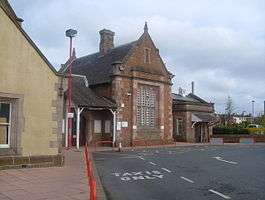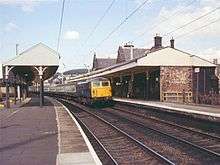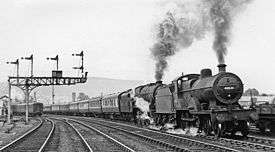Penrith railway station
| Penrith North Lakes | |
|---|---|
 | |
| Location | |
| Place | Penrith |
| Local authority | District of Eden |
| Coordinates | 54°39′43″N 2°45′29″W / 54.662°N 2.758°WCoordinates: 54°39′43″N 2°45′29″W / 54.662°N 2.758°W |
| Grid reference | NY511299 |
| Operations | |
| Station code | PNR |
| Managed by | Virgin Trains |
| Number of platforms | 3 |
| DfT category | D |
|
Live arrivals/departures, station information and onward connections from National Rail Enquiries | |
| Annual rail passenger usage* | |
| 2012/13 |
|
| 2013/14 |
|
| 2014/15 |
|
| 2015/16 |
|
| 2016/17 |
|
| Listed status | |
| Listed feature | Penrith Station |
| Listing grade | Grade II listed |
| Entry number | 1326905[1] |
| Added to list | 9 February 1983 |
| National Rail – UK railway stations | |
| * Annual estimated passenger usage based on sales of tickets in stated financial year(s) which end or originate at Penrith North Lakes from Office of Rail and Road statistics. Methodology may vary year on year. | |
|
| |
Penrith North Lakes railway station[2] (often shortened to Penrith[3]) is located on the West Coast Main Line in the United Kingdom. It serves the town of Penrith, Cumbria, and is less than one mile from its centre. National Express coaches leave from the station's car park and there are bus links to Keswick, Workington, Appleby-in-Westmorland and Ullswater.
Background


The station was built by the Lancaster and Carlisle Railway, it was opened on 17 December 1846,[4] and was designed by Sir William Tite.[1] Although the station is now relatively quiet at one time this was the terminus for the Cockermouth, Keswick and Penrith Railway and the North Eastern Railway's Eden Valley branch which joined with the Stainmore line at Kirkby Stephen providing connections to the East Coast Main Line at Darlington. There was also in the mid-nineteenth century a plan to connect Penrith by rail to the lead mines at Caldbeck and eventually joining up with the Cumbrian Coast Line near Wigton. Passenger services to Kirkby Stephen and Darlington were withdrawn in 1962, whilst those to Cockermouth and Workington fell victim to the Beeching Axe four years later; the surviving portion of the C&KP to Keswick survived until March 1972.
The station currently lacks a cafe. An 1863 Ordnance Survey plan[5] shows refreshment facilities in the large room seen to the right on entering the building, but this is now used for storage.
The station was renamed from Penrith to Penrith for Ullswater in the early years of British Railways;[4] and the name reverted to Penrith on 6 May 1974.[4][6] It has since been renamed again to Penrith North Lakes.
Up until August 2006 the station was probably unique in that although being a manned main line station it did not have electronic departure boards or TV screens depicting departures/arrivals but only a handwritten departure board in the waiting room/ticket office. It was also the last station in the UK where mail was collected by a moving train, the practice finally coming to an end in October 1971.[7]
The station is operated by Virgin Trains, who refer to the station as Penrith North Lakes.[3] It is recorded in the National Heritage List for England as a designated Grade II listed building.[1]

Facilities
The station is staffed throughout the day, with the ticket office open from 05:30 - 19:00 Mon-Sat and 10:30 - 19:00 on Sundays. A self-service ticket machine is also available. Train running information is now offered via CIS displays, automated announcements and customer help points on the two main platforms (platform 3 is rarely used). Waiting rooms are provided on both platforms, along with toilets, a vending machine for snacks and cold drinks, a post box and a pay phone. Step-free access is available to all platforms via lifts.[2]
Services
There are calls provided here throughout the week by both Virgin Trains and TransPennine Express - the former mostly by Glasgow Central to London Euston direct trains and the latter by Manchester Airport to Glasgow/Edinburgh services. These combine to provide a minimum of one hourly departure in each direction. Some Virgin workings via Birmingham New Street also stop here at certain times of day (mainly morning & evening peak periods), whilst the last evening train southbound terminates at Crewe.[8]
See also
References
- 1 2 3 Historic England, "Penrith station (1326905)", National Heritage List for England, retrieved 21 November 2016
- 1 2 Penrith station facilities National Rail Enquiries
- 1 2 Virgin Trains - our routes and stations
- 1 2 3 Butt, R.V.J. (1995). The Directory of Railway Stations. Yeovil: Patrick Stephens Ltd. p. 183. ISBN 1-85260-508-1. R508.
- ↑ Ordnance Plan of the town of Penrith (10.56 feet to one mile), 1863, British Library shelfmark O.S.T.(11)
- ↑ Slater, J.N., ed. (July 1974). "Notes and News: Stations renamed by LMR". Railway Magazine. London: IPC Transport Press Ltd. 120 (879): 363. ISSN 0033-8923.
- ↑ The Travelling Post Office - History www.allanyeo.co.uk; Retrieved 2013-12-18
- ↑ GB National Rail Timetable May 2017 Edition, Table 65 (Network Rail)
External links
| Wikimedia Commons has media related to Penrith railway station. |
- Train times and station information for Penrith railway station from National Rail
| Preceding station | Following station | |||
|---|---|---|---|---|
| Oxenholme Lake District | Virgin Trains West Coast Main Line |
Carlisle | ||
| Lancaster | ||||
| Preston | ||||
| Lancaster | TransPennine Express TransPennine North West |
Carlisle | ||
| Oxenholme Lake District | ||||
| Disused railways | ||||
| Terminus | Eden Valley Railway | Clifton Moor | ||
| Blencow | Cockermouth, Keswick and Penrith Railway | Terminus | ||
| Historical railways | ||||
| Clifton & Lowther | London and North Western Railway Lancaster and Carlisle Railway |
Plumpton | ||